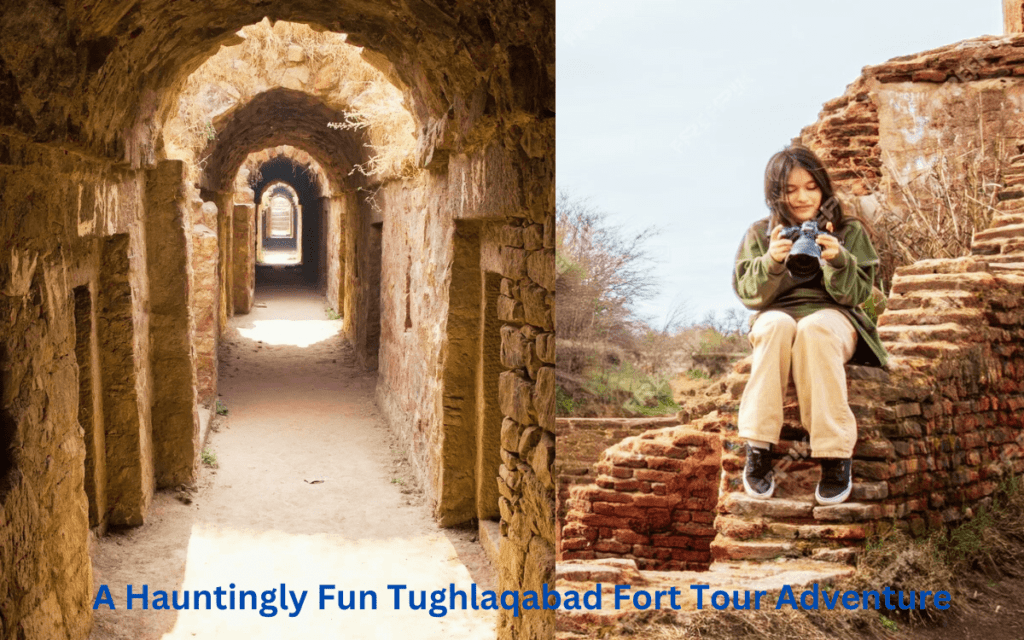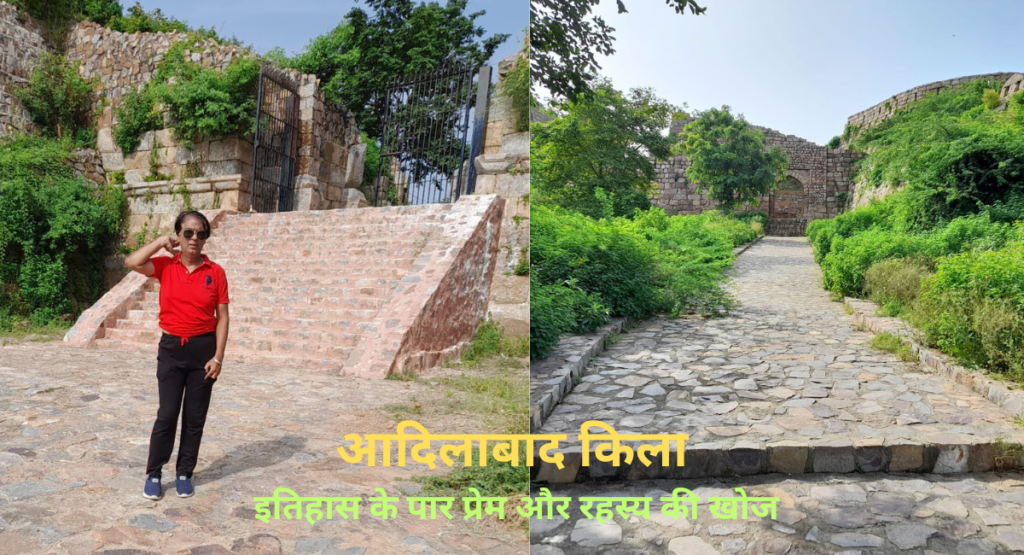Tughlakabad Fort Tour Guide welcomes you to the heart of Delhi’s history, a journey through the enigmatic remnants of a bygone era. As you traverse Badarpur Mehrauli Road in South Delhi, the scattered ruins emerge, inviting you to witness the grandeur that once defined this formidable Sultanate stronghold. Picture the half-broken sloping walls, towering bastions, and fractured arches that unfold tales of Sultans, Amirs, and Jagirs. This is the legacy of Tughlakabad—a fortified city embodying power, ambition, and the twists of fate. Amidst the cracks and crevices, weeds and bushes, our tour guide, a storyteller, breathes life into history, weaving a narrative of resilience and grandeur. Join us on this journey through time and architecture, exploring the captivating history and architectural marvels that shaped Delhi’s Sultanate era.
Tughlakabad Fort Tour Guide: Over View

Embark on a fascinating exploration of Tughlakabad Fort with your guide, Harry, a seasoned Tughlakabad Fort tour guide who skillfully weaves together the rich tapestry of Delhi Sultanate history. As you are picked up from your hotel, Harry begins to narrate the tales and anecdotes of the mighty Tughlaq Sultans who once ruled over a grand empire with honor and strength. The tour spans 4 hours with three distinct stops: the ruins of the fort, the tomb, and Adilabad Fort.
Open the gates of Tughlakabad Fort and immerse yourself in a mysterious journey through history, expertly guided by Harry, your Tughlakabad Fort tour guide. Harry welcomes you to a captivating experience where the echoes of the past resound through every step. Wander through the city’s remains, divided into bustling streets, a royal citadel crowned by the Bijai-Mandal Tower, and palace areas that once housed regal residences. The Tughlakabad Fort stands as a testament to the dreams and ambitions of Ghazi Malik, and under Harry’s guidance, every stone reveals a story, and every corner holds a secret waiting to be unveiled. Let this Tughlakabad Fort tour be your gateway to an enchanting voyage through time.
Delhi with Tour Guide for Must Visit Places
Haunting Hilarity A Tughlakabad Fort Adventure Like No Other

Harry, our Tughlaqabad Fort tour guide, deserves the highest accolades for making our journey both hauntingly intriguing and uproariously fun. Her skillful narration of haunting stories intertwined with a touch of humor added an unmatched charm to the experience. Exploring the fort under her guidance was not just a historical exploration but a delightful adventure filled with laughter and awe. The blend of spooky tales and light-hearted anecdotes created an atmosphere of both excitement and amusement. We wholeheartedly recommend anyone visiting Tughlaqabad Fort to choose Harry as their guide. Her expertise, wit, and unique storytelling style truly elevated our visit, making it an unforgettable, entertaining, and educational experience…Julia Harries
Whispers of History: Harry’s Insightful Journey Through Tughlakabad Fort and Beyond

In the barren expanse of Tughlaqabad Fort, Tomb, and Adilabad Fort ruins, each stone whispers tales of history. Booking Harry as my guide was a stroke of luck, transforming the journey into an unforgettable adventure. Her knowledge is as expansive as the fort’s landscape, making every historical nugget come alive. With Harry, the tour felt like a stroll with a knowledgeable friend, enriching the experience. I wholeheartedly enjoyed her company, and her passion for storytelling made the ruins vibrant with the echoes of the past. For an insightful and enjoyable exploration, I highly recommend Harry as your Tughlaqabad Fort tour guide.
Mehrauli Archaeological Park Walk-Delhi’s Timeless Heritage
Tughlakabad Fort: Nearest Metro Station
Sarita Vihar Metro Station on Violet Line is 2.1 km from Tughlakabad Fort
Govind Puri Metro Station on Violet Line 3 Km from Tughlakabad Fort
Tughlakabad Fort Tour Guide: History
Tughlakabad Fort was built in 1321 by Ghiyasuddin Tughlaq, the first ruler of the Tughlaq dynasty. Tughlaq’s name was Ghazi Malik and he started off as a governor during the reign of Alauddin Khilji. According to popular legend, when Mubarak Khilji ascended the throne of his father, Ghazi Malik suggested the construction of a fortified city during his reign.
Ghazi Malik was a vassal of Khilji Sultan who occupied Delhi. Once, while patrolling the Qutub Minar with his master, he proposed to build a fort on a hill in the southern part of Delhi. The Sultan jokingly said that Ghazi Malik, whenever you take over the throne of Delhi, build your fort here on that day. It just happened that way. Later on, the chess pieces of fate turned in such a way that God proved his master’s words to be true. Because Ghazi Malik ousted the Khilji Sultans from the throne of the Delhi Sultanate in 1321 and assumed the title of Ghiyasuddin Tughlaq, some historians believe that this was a coup plot by Ghazi Malik, who later ruled the region. Foundation of Tughlaq dynasty laid. He immediately began building the city he had once dreamed of, including a beautiful and luxurious palace to protect against enemies.
In those days, the morale of the Mongols was high and the route to Delhi Sultanate via Khyber Pass via Lahore had been laid by their horses. Tughlaq wanted to build a fort that could protect the Delhi Sultanate, which was impregnable. So he employed workers to plan a fort with high and lofty walls, so that the enemy could be identified and attacked from a distance. The fort was part of a larger city, with a palace area for the royal family to live in, as well as houses on the shore. A dam was built to stop the naturally flowing stream and canal water flowing from Mehrauli Shamshi pond and convert it into a lake. Apart from being a reservoir, this lake must also have been acting as a barrier for the incoming enemies.
See Qutub Minar History and Architecture Near by Places to Visit

Tughlakabad Fort Tour Guide: Architecture
Tughlakabad Fort still has several impressive and massive stone forts that surround the irregular ground plan of the city. The ruins and sloping city walls are a regular feature of the monuments of the Tughlaq dynasty. They are approximately 10–15 meters high, with battlement walls, chhatris and round turrets up to two storeys high. The city reportedly once had 52 gates and only 13 exist in modern times. According to reports, there were seven rainwater tanks in the then fortified city.
The Tughlakabad Fort has three parts, i.e. its vast city area, with houses built in a rectangular grid between the gates and the fort, with Bejai Mandal at the highest point. There are also the remains of several halls and a long underground passage. In the immediate area of the palace are the residences of the royal family, an underground passage still exists under the tower. In recent times, a large part of it is inaccessible due to the dense vegetation around the city. A large part is occupied by numerous settlements, especially towards the lakes. South of the city A beautiful water lake was built around the tomb of Ghiyasuddin Tughlaq. Was. This tomb is connected to the fort by a high causeway. The remains of Adilabad Fort can be seen towards the south-east corner and it was built many years later by Muhammad bin Tughlaq.

This is a secret passage of Tughlakabad Fort which was excavated in the 1990s and revealed a huge passage with warehouse and a hidden secret door and exit. This hidden path leads to a small hole in the outer part of the fort wall, which looks exactly like a drain from outside. I tried to find the hole from outside the fort but failed.
Ghiyasuddin Tughlak’s Tomb: Tughlakabad Fort Tour Guide
Tomb of Ghiyasuddin Tughlaq – a magnificent example of architecture steeped in history and tales of intrigue. Ghiyasuddin Tughlaq occupied the throne of Delhi Sultan for only four years from 1320 to 1324. By all accounts he was a just and capable ruler. Who has rarely resorted to bloodshed. However, his death is a story shrouded in mysterious circumstances.

The fortress-like tomb of the Sultan of Delhi is much more than a grand mausoleum. The tomb of Ghiyasuddin Tughlaq, who ruled the Delhi Sultanate from 1320 to 1325, is located near the Great Fort of Tughlakabad. A section of the old path still connects the massive fort and the emperor’s smaller fort-like mausoleum, located on top of a small hill. The massive red sandstone and marble mausoleum stands at the center of a pentagonal fortified complex, replete with bastions and battlements. This tomb is built in the typical Tughlaq architectural style. The single-domed mausoleum has a square base and walls of sandstone. The huge white marble dome rests on an octagonal drum and is decorated with a unique lotus finial. Although devoid of any ornamentation, the inlay of white marble on red sandstone forms an attractive feature. In appearance it looks more like a palace than a graveyard. This tomb was built by Ghiyasuddin Tughlaq himself and he was unaware of the unfortunate death that awaited him. Tughlaq died suddenly in 1325 while returning to Delhi after capturing Bengal. He was attending a reception given by his eldest son Muhammad bin Tughlaq at Afghanpur (present-day Bihar) when the pandal suddenly collapsed, killing the ruler and his other companions. The tomb has three arched doors, and on the fourth side – the west side – there is an arch. Inside the mausoleum are the tombs of Ghiyasuddin Tughlaq, his wife Begum Makhdooma Jahan and their son Prince Muhammad bin Tughlaq.
Ibn Battuta Documentary Evidence By Tughlakabad Fort Tour Guide
We have documentary evidence in which Ibn Battuta described the palace of Tughlakabad in 1332. There was a special palace near the Tughlakabad fort whose tiles he had plated with gold, so that when the sun rose it looked magnificent. Shine with light and dazzling brilliance.” He amassed a wealth of wealth in the city and is said to have built a tank and poured molten gold into it until it became a solid block.
Curse by Sufi Saint:Tughlakabad Fort Tour Guide

It is said that Tughlaq loved this dream city so much that he ordered every laborer in the Delhi Empire to work on its construction. It is said that at the same time the city and the fort were being constructed, the Sufi saint Nizamuddin Auliya was constructing a staircase at his residence. Since everyone was busy in the construction of the fort, he was not able to find laborers to build his stepwell. Therefore, laborers worked on the fort during the day, and constructed the stepwell at night. When Tughlaq came to know that Nizamuddin Auliya was employing his labourers, he became angry. In a fit of anger, he cut off the oil supply so that no lamps could be lit for work at night.
Another popular legend says that Tughlaq was in Bengal when he came to know about the laborers. He vows to take revenge on Yuvraj upon his return. In reply Saheb said “Hunuz Delhi Door Ast” Tughlakabad Fort History Curse (Delhi is still far away). It is said that in this manner, enraged mystic saint Nizamuddin had converted the water from his well into oil. He cursed the city of Tughlakabad, saying “Ya Rahe Ajar Ya Bees Gujjar”, which translates to “It will remain desolate or be taken over by herdsmen”. While returning Tughlaq died suddenly when a pavilion built in his honor fell on him and his young son.
Visiting the Dargah of Hazrat Nizamuddin Auliya makes you feel relaxed and peaceful.
Old Step Well With Tughlakabad Fort Tour Guide

Sultan Ghiyasuddin Tughlaq, keeping in mind the need of water in Tughlakabad Fort and the city, ordered the construction of several stepwells, only two of which can be seen in the fort. Today they are also known as the Eastern and Western Baoli, both of which date back to the 14th century architecture. East Bowli, known as Purani Bowli, can be reached by descending 30-steps.
Tughlakabad Fort Delhi Tour Guide: Information
Information about Tughlakabad Fort
The tomb of Ghiyasuddin Tughlaq is connected to the southern outpost of the fort by a causeway. The elevated causeway is up to 600 feet long and supported by 27 arches, passing through an artificial lake. After passing through an ancient Peepal tree, the Ghiyasuddin Tughlaq tomb complex has an entrance gate made of red sandstone leading to stairs. This mausoleum is a domed tomb with square shaped roofs and sloping walls. The sides are of smooth red sandstone and surrounded by carved panels and marble arched borders. The building has a beautifully shaped dome on an octagonal drum which is covered with white marble and slate slabs.
Inside the mausoleum, you will find three tombs, namely the central tomb of the emperor himself and two others, believed to be those of his son Muhammad bin Tughlaq and his wife. There is another octagonal mausoleum of similar design with a small marble dome and arched doorways with carved sandstone and marble slabs. According to the inscription, the remains of Zafar Khan are present in this tomb.
Adilbad Fort: Nearby With Tughlakabad Fort Tour Guide
Adilabad Fort stands silently in the south-eastern part of Tughlakabad in Delhi and was connected to Tughlakabad Fort a few years later by a kilometer long causeway. The fort was built by Sultan Muhammad bin Tughlaq, son of Sultan Ghiyasuddin Tughlaq, it was designed in imitation of Tughlaq’s fort, and has archaic architecture with large sloping walls with bare surfaces, it has crenellations and There is a curved arch with nothing in it.

Historically, Muhammad bin Tughlaq was also fond of beautiful forts and spent much of his time planning the beauty of his newly founded city of Tughlakabad. Like his father, he continued building the fort and later expanded his city on vast acres of land, including lush green fields and spaces, which were not used by Alauddin Khilji, the previous ruler of the Khilji dynasty. Sri Qila, ‘Tughlakabad city and the Qutb complex at Mehrauli in Delhi which formed the new ‘Jahan Panah’ city of the Sultan and his family.
Adilabad Fort was a very small fort compared to the magnificent Tughlakabad Fort. Which housed the royal family and royal courtiers of the Turkish dynasty along with some administrative halls. Courts and courts used to be held here.
Tughlakabad Fort: Advice by Delhi Tour Guide
When setting out on a trip to Tughlakabad Fort, be prepared to step into a realm of scattered ruins and raw history. Exploring this barren beauty is best enjoyed with a fellow adventurer as you traverse its mysterious paths. Choose comfortable, light shoes that are ideal for walking, allowing you to walk gently on its ancient stones. Don’t forget to carry a bottle of water, ensuring you stay refreshed as you unravel the mysteries woven into the fabric of this intriguing fort.
Tughlakabad Fort: Ticket
Ticket for Tughlakabad Fort is Rs 25/ Cash
Ticket for Tughlakabad Fort 300/ forigen nationals
Tughlakabad Fort: Timing
8 Am to 6 Pm Best Time to visit in the morning Time. As Tughlakabad Fort is an abandoned Area








